Last updated: October 31, 2023
Article
Discover the Resilient Subalpine Forest of Paradise

NPS/S.Redman Photo
The ancient lowland forests of the Pacific Northwest are world famous. No wonder, with great conifer trees that can reach heights of over 350 feet, attain trunk diameters exceeding 12 feet, and live beyond 1,500 years. Middle elevation forests can be venerable too. They might remind visitors of northern mixed forests in the Great Lakes and New England regions. But the open, subalpine forests of the Pacific Northwest are beloved for their gnarled trees and park-like character, their generous heath and huckleberry shrubbery, and their sublime flower meadows. You can nurture your own understanding and connection with the subalpine parkland by discovering the forests of Paradise at Mount Rainier National Park.
The subalpine parkland of Paradise begins at around 4,800 feet elevation and extends to treeline at about 6,800 feet. Begin with a map of the Paradise trails and choose the Nisqually Vista trail. Hiking boots and trekking poles are recommended. You can access the Nisqually Vista trail from the granite staircase north of the Jackson Visitor Center. Turn left onto the Avalanche Lily trail and take another left down lower Deadhorse Creek trail in a quarter mile. As Deadhorse Creek trail meets Nisqually Vista trail turn right. Or start at the stairs at the far-right end of the lower parking lot of Paradise. Turn left at the top of the stairs.
All of Mount Rainier's subalpine meadows are classified as maritime timberline zones. The presence of mountain hemlock and Alaska yellow cedar are indicators of the maritime influence. A weather station at Paradise has given a reliable climate record here for over 100 years. The average snowfall is 670 inches and the yearly precipitation is 105-120 inches. The snowpack can grow from 15 to 30 feet deep. In particularly cool and snowy years, the meadow can remain snow covered until August. All this snow and chill greatly inhibits tree establishment and growth. Studies of fossilized pollen in lake sediments on the Olympic Peninsula indicate that the ecosystems we see nowadays had developed and stabilized by about six or seven thousand years ago.
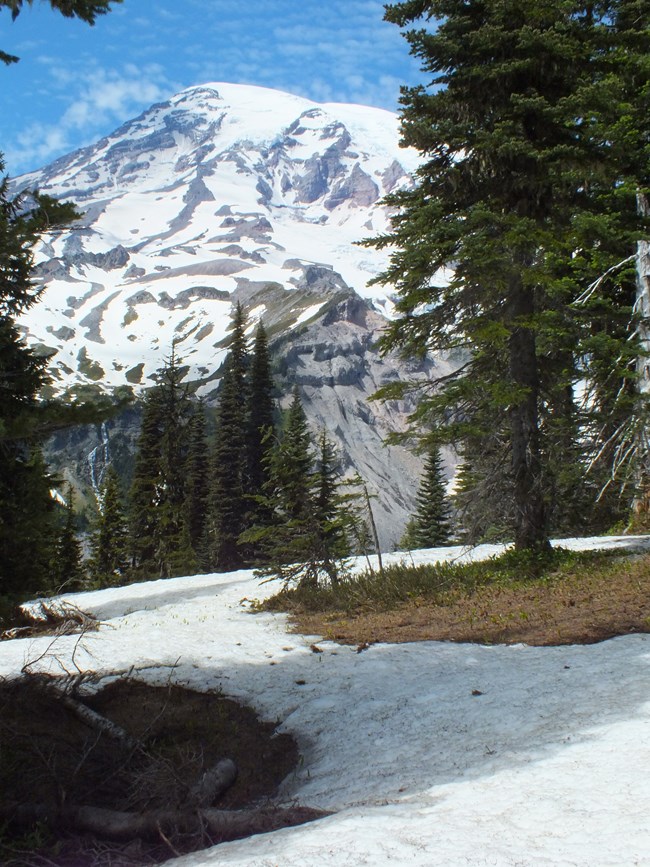
NPS/S.Redman Photo
As you walk Nisqually Vista trail, notice how the thicker stands of trees occupy the ridges while the small valleys have few trees. Do you think this is due to snowpack or perhaps other factors? At the overlooks, notice the unvegetated gravel walls below. These are called glacial moraines. Did the Nisqually Glacier dump that gravel there recently? How could the glacier have been that large just within the last few hundred years? Yet higher on the cliffs and across the valley in the Wilson-Van Trump parkland, the trees are both gnarled and perfectly formed.
As you walk the south section of Nisqually Vista trail look for huge clumps of subalpine trees. What is the advantage of clumping together like that? You also have the opportunity here to focus on the soil of the subalpine forest. Can you see any large grains of yellow sand spilling out of the banks along trail? This is volcanic ash or tiny grains of pumice from eruptions. The park's soils contain a record preserved in ash layers of eruptions from not only the Mount Rainier volcano but ash layers deposited from Mount Mazama (Crater Lake), Mount St. Helens, and other nearby volcanoes. These ash layers make the soils here quite well drained, but there is a peaty quality to the soil also from the slow breakdown of dead plants including sedge, mosses, lichen, and tree and shrub wood and leaves. The soil pH is likely acidic. Do you think that fungi, insects, birds and mammals also play important roles within the drama of the soil world here?
Once you have completed the Nisqually Vista trail, turn left opposite the stairs to the lower parking lot and hike slowly northward up the Deadhorse Creek trail. Now the stream will also be to the left. Do you see the huge, fallen tree trunks? What about the standing, dead tree snags and stumps? Are they important characters in the story of the subalpine forest? Why do you think that they might be? Have you seen any inspiring birds, mammals or insects so far on this journey? What roles (beyond the soil world just considered) might they play in the story of this place?
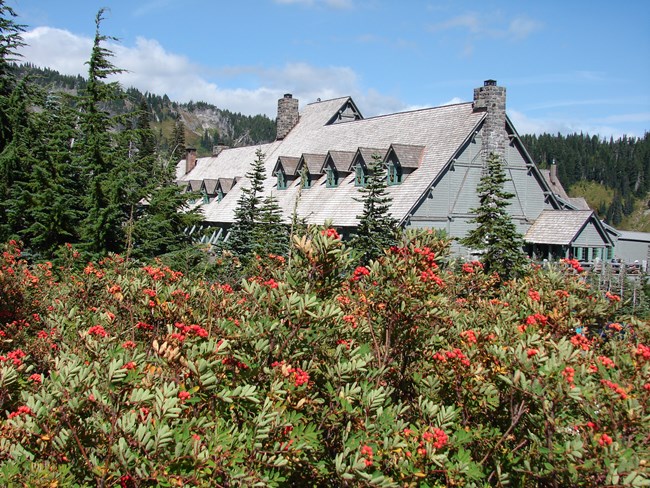
NPS/S. Redman Photo
After about an eighth of a mile up Deadhorse Creek trail turn right onto the Avalanche Lily trail and follow it east to the visitor center. Are there any old trees around you? Do you think that they could live to be a thousand years old in this habitat? Are the young sapling trees of different kinds than the old trees?
Do you see the dead, silver tree trunks north of the visitor center? Why did they die? What agents might cause tree death up here?
Continue from Avalanche Lily trail to East Skyline trail toward Myrtle Falls. How many different kinds of shrubs do you see along this section of the trail? How do you suppose that they are important members of this ecological community?
Can you see the Paradise Inn now? It was built of Alaska yellow cedar wood in 1916. This is a good place along this journey to consider the trees of Paradise. Just four species are adapted to life up here. Looking about you will notice three of these species.
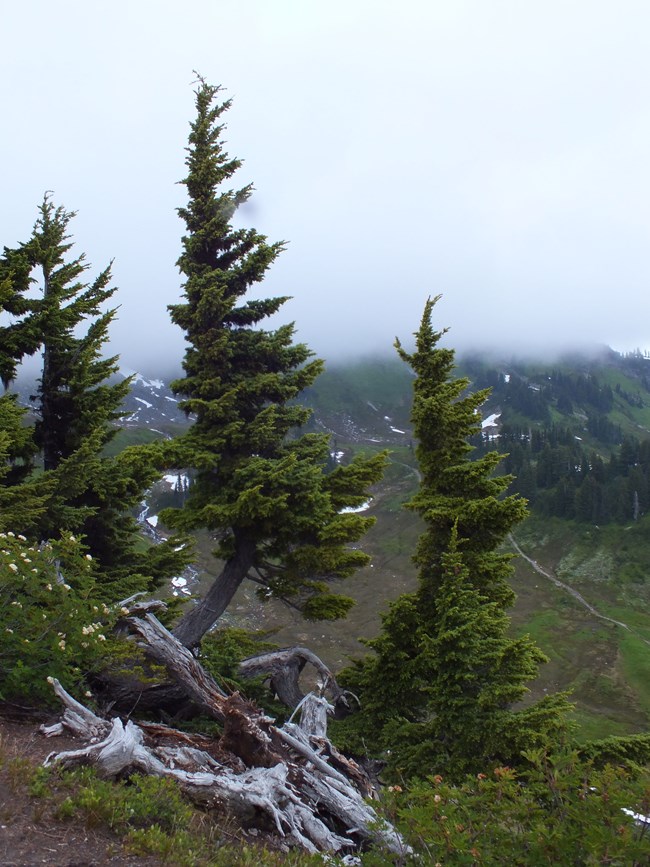
NPS/S. Redman Photo
The most widespread is subalpine fir, Abies lasiocarpa. Look for its blue leaves (called needles), large, upright, purple cones and perfectly symmetric branch pattern. Are the tops or canopy of these trees also very narrow? Why so? Are all the fir so perfect or do some have crooked trunks, broken tops, new lead branches, or branches missing from the side of the tree facing the prevailing winds of winter?
The second most common tree of Paradise is mountain hemlock, Tsuga mertensiana. It usually has very dark green needles and droopy branch tips. Some specimens can have a blue cast to the needles. Old hemlocks have deeply furrowed bark.
Alaska yellow cedar, Callitropsis nootkatensis is the least abundant of the three common tree species in Paradise. It prefers to live in avalanche tracts where there is less competition from the other two tree species. Alaska yellow cedar is the longest-lived tree species in Washington state. 2,000-year-old specimens have been observed. How do you think it achieves such great longevity?
All of these tree species have the amazing ability to reproduce by layering and by seed. Layering is a type of asexual reproduction that occurs when the lower branches touch the soil and new roots grow right out of the branches and produce new stems that are genetically identical to the parent tree. This allows them to live right up to treeline and persist as shrubs. These types of shrub stands are known as krummholz. Such mats of krummholz can even grow many feet down cliffs. That is an amazing thing to see on the upper Skyline trail.
Common juniper, Juniperus communis var. horizontalis will join these others in the krummholz community. All of them can withstand temperatures as low as -20 Fahrenheit here, although it seldom get colder than 0 Fahrenheit at this elevation.
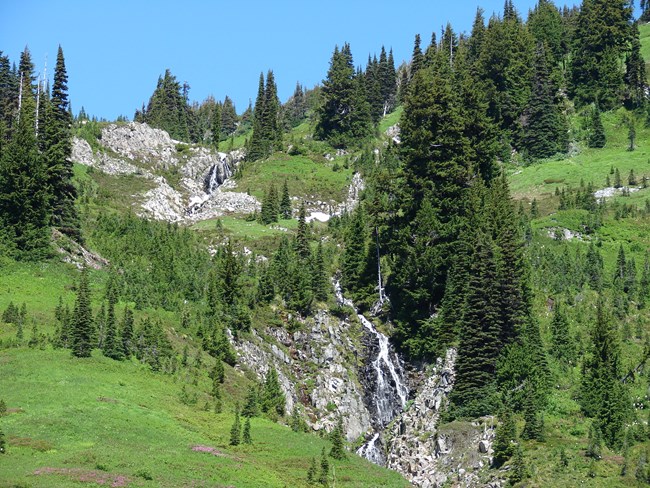
NPS/S. Redman
The fourth tree species of Paradise is the Pacific silver fir, Abies amabilis. It is the most widespread tree species in Mount Rainier National Park. It prefers the middle elevation forest habitat. It looks very similar to subalpine fir but its needles are deep green colored not bluish. It is very shade tolerant and capable of dominating old forest stands. See if you can identify any Pacific silver fir seedlings or saplings as this adventure continues.
Look for some wooden benches on the right as you continue toward Myrtle Falls. Notice behind the benches how the stand of trees has a hollow spot in the middle and an old stump in there. Do you think that one of two trees established this stand long ago? Perhaps the original trees created a warmer, more protected place for the other trees and shrubs to germinate?
Just a short distance up trail and to the right will be a view to the upper Paradise River watershed. You may also see Sluiskin Falls to the northeast on Mazama Ridge. Notice how the forest down there does form closed-canopy stands in some places. How would you explain that?
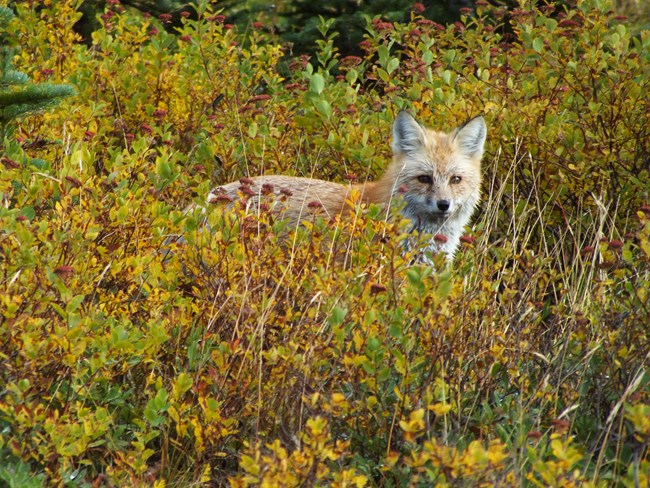
NPS/S. Redman Photo
As you arrive at the Myrtle Falls area, see how the stream basin (Edith Creek) has very few trees, while the Alta Vista Ridge to the left and the Goldengate Ridge to the upper right have lots of trees. Contrast this scene with the Paradise River Valley just observed. Might the clear difference be related to the extent of glaciers and large snowfields in recent climate history?
The journey is nearly complete but an inspiring discovery is just a quarter mile up trail. Turn right at the fork in the trail after the Edith Creek Bridge. Walk until coming to a small stand of huge subalpine trees on the right. What are these species? How old might they be? Please stay on the trail to avoid compacting the soil around these ancient trees. Soil compaction can restrict the oxygen and water supplies to the tree roots, ruin the soil and kill the trees. Keep walking and look about 20 feet back into this stand. You may now be in the realm of the largest mountain hemlock in the Paradise area. It might be 500 or even 700 years old. What is your guess? If you are quiet and patient near the rocks up ahead to the left, you may see rare wildlife.
Thanks for taking the time to begin a relationship with the subalpine forest of Paradise. Are you inspired to nurture a deeper connection with this life community? You can also celebrate the wonders of subalpine life in Paradise on many of the upper trails here and in all the four seasons. Perhaps you might also discover other subalpine parklands of Mount Rainier in such places as Chinook Pass, Yakima Park and Spray Park.
If you could see 50 or 100 years into the future or revisit at those times, in what ways do you think the ecosystem will change with the climate? How might our human stewardship of such places also change? To expand our thinking and immersion into those subjects, you might consider if the subalpine ecosystem is a good model for land nurturing in domestic and agricultural areas. Would you like to help nurture subalpine-like gardens and woodlands near your home and neighborhood? You are certainly encouraged to do so for the sake of pollinators and other vital native insect communities, for biological diversity conservation, and for human health, wellness and sustainability. Thanks again!
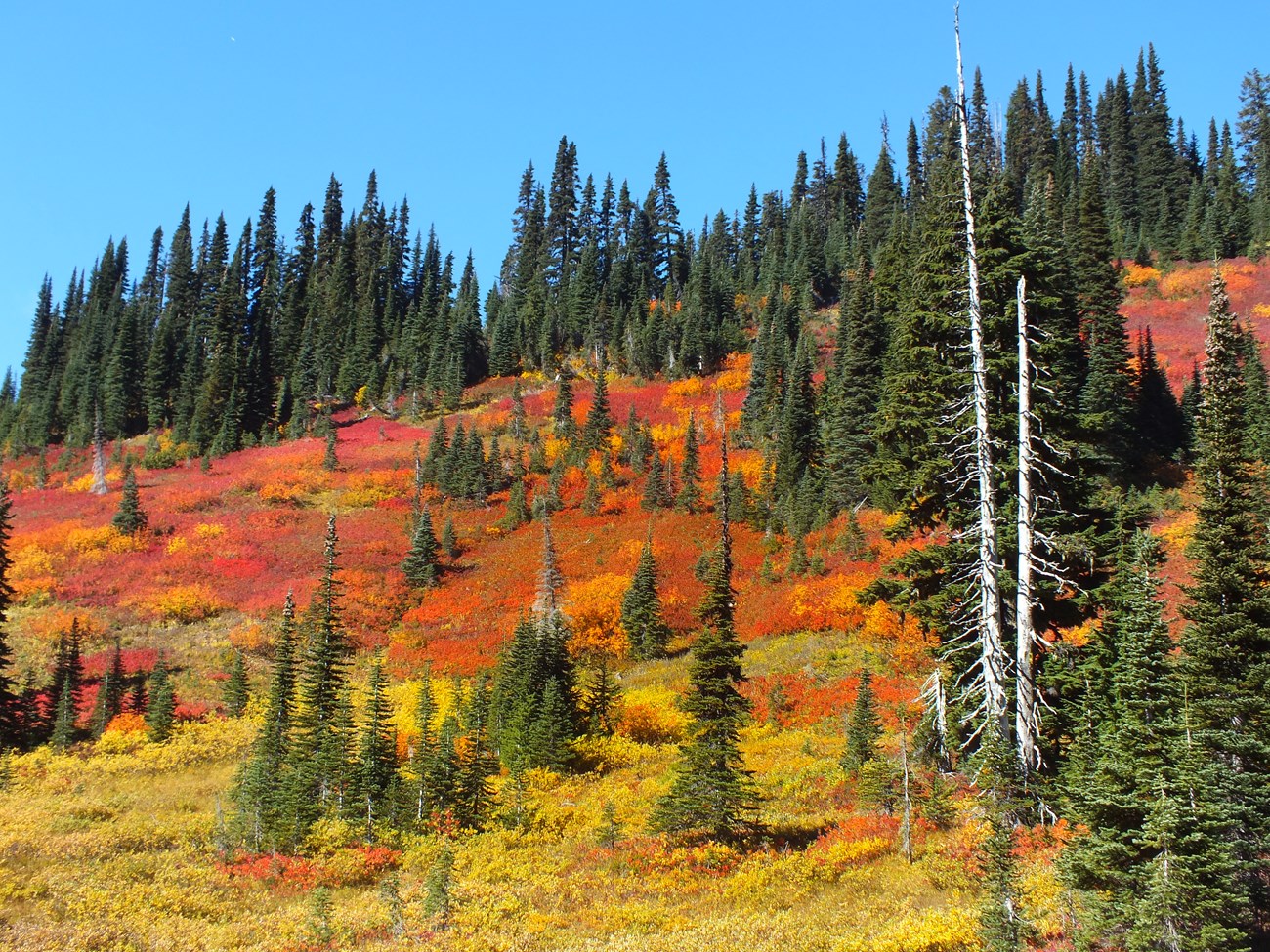
NPS/S. Redman Photo
References and Resources:
- nps.gov/olym/learn/nature/subalpine-forest.htm
- researchgate.net
- Post-glacial History of Subalpine Forests, Olympic Peninsula, Washington, USA, 2001 by D Gavin, J.S. Mclachlan, L.B. Brubaker and K.A. Young.
- en.wikipedia.org/Ecology-of-the-North-Cascades Forest
- Communities of Mount Rainier National Park by Franklin, J., et. al., 1988. Pojar, J. and MacKinnon, A. 2013. Alpine Plants of the Northwest, Lone Pine Publishing, Edmonton, Alberta, Canada. Taylor, RJ., Douglas, GW., 1995.
- Mountain Plants of the Pacific Northwest, Mountain Press Publishing, Missoula, Montana. Mathews, D., 1999.
- Cascade-Olympic Natural History: A Trailside Reference. Publishers Press, Raven Editions, Portland, Oregon.
